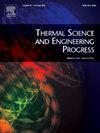Estimation of the windage loss and heat transfer characteristics inside the finite length of electrical machines’ airgap based on CFD and MLA
IF 5.4
3区 工程技术
Q2 ENERGY & FUELS
引用次数: 0
Abstract
The performance of electric machines heavily depends on the airgap length, as it affects magnetic energy transfer. A larger airgap increases the magnetic circuit reluctance, reducing output power but making heat removal easier. A numerical approach estimates airgap heat transfer and windage loss, validated against analytical correlations based on Taylor-Couette flow, with the inner cylinder rotating and the outer stationary. Heat transfer and windage loss correlations are developed for various airgap ratios (G) and aspect ratios (AR). Skin friction coefficients for different airgap geometries are estimated to calculate windage loss for high Reynolds and Taylor numbers. The airgap ratio significantly impacts heat transfer, while the aspect ratio strongly affects windage loss. Machine Learning Algorithms (MLAs) are trained and tested on 1200 data points from high-fidelity Computational Fluid Dynamics (CFD) and Computational Heat Transfer (CHT). Comparisons of Artificial Neural Network (ANN), Random Forest (RF), and Support Vector Regressor (SVR) performances against CFD data show that ANN predicts skin friction coefficients best, while SVM excels in predicting windage loss and the Nusselt number.
基于CFD和MLA的电机气隙有限长度内的风损和传热特性估算
电机的性能在很大程度上取决于气隙的长度,因为它影响磁能的传递。较大的气隙增加了磁路磁阻,降低了输出功率,但使散热更容易。一个数值方法估计气隙传热和风损,验证了基于Taylor-Couette流的分析相关性,内部圆柱体旋转,外部静止。研究了不同气隙比(G)和长径比(AR)的传热和风损关系。估计了不同气隙几何形状的表面摩擦系数,以计算高雷诺数和泰勒数的风阻损失。气隙比对传热影响显著,展弦比对风损影响较大。机器学习算法(MLAs)在来自高保真计算流体动力学(CFD)和计算传热(CHT)的1200个数据点上进行训练和测试。人工神经网络(ANN)、随机森林(RF)和支持向量回归器(SVR)与CFD数据的比较表明,人工神经网络(ANN)对皮肤摩擦系数的预测效果最好,而支持向量回归器(SVM)在预测风损和努塞尔数方面表现出色。
本文章由计算机程序翻译,如有差异,请以英文原文为准。
求助全文
约1分钟内获得全文
求助全文
来源期刊

Thermal Science and Engineering Progress
Chemical Engineering-Fluid Flow and Transfer Processes
CiteScore
7.20
自引率
10.40%
发文量
327
审稿时长
41 days
期刊介绍:
Thermal Science and Engineering Progress (TSEP) publishes original, high-quality research articles that span activities ranging from fundamental scientific research and discussion of the more controversial thermodynamic theories, to developments in thermal engineering that are in many instances examples of the way scientists and engineers are addressing the challenges facing a growing population – smart cities and global warming – maximising thermodynamic efficiencies and minimising all heat losses. It is intended that these will be of current relevance and interest to industry, academia and other practitioners. It is evident that many specialised journals in thermal and, to some extent, in fluid disciplines tend to focus on topics that can be classified as fundamental in nature, or are ‘applied’ and near-market. Thermal Science and Engineering Progress will bridge the gap between these two areas, allowing authors to make an easy choice, should they or a journal editor feel that their papers are ‘out of scope’ when considering other journals. The range of topics covered by Thermal Science and Engineering Progress addresses the rapid rate of development being made in thermal transfer processes as they affect traditional fields, and important growth in the topical research areas of aerospace, thermal biological and medical systems, electronics and nano-technologies, renewable energy systems, food production (including agriculture), and the need to minimise man-made thermal impacts on climate change. Review articles on appropriate topics for TSEP are encouraged, although until TSEP is fully established, these will be limited in number. Before submitting such articles, please contact one of the Editors, or a member of the Editorial Advisory Board with an outline of your proposal and your expertise in the area of your review.
 求助内容:
求助内容: 应助结果提醒方式:
应助结果提醒方式:


